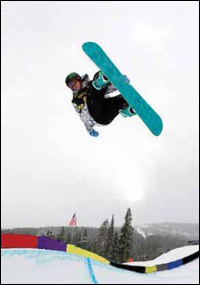Concussion in Winter Sports
 Get prepared for concussions on and off the ice and slopes. Learn the symptoms and danger signs and keep an action plan on hand.
Get prepared for concussions on and off the ice and slopes. Learn the symptoms and danger signs and keep an action plan on hand.
Each winter, hundreds of thousands of young athletes head out to ice and ski slopes to enjoy, practice, and compete in various winter sports. There's no doubt that these sports are a great way for kids and teens to stay healthy, as well as learn important leadership and team-building skills. But there are risks to pushing the limits of speed, strength, and endurance. And athletes who push the limits sometimes don't recognize their own limitations—especially when they've had a concussion.

Photo © Tom Zikas
A concussion is a type of traumatic brain injury—or TBI—caused by a bump, blow, or jolt to the head or by a hit to the body that causes the head and brain to move rapidly back and forth. This sudden movement can cause the brain to bounce around or twist in the skull, stretching and damaging the brain cells and creating chemical changes in the brain.
While most athletes with a concussion recover quickly and fully, some will have symptoms that last for days or even weeks. A more serious concussion can last for months or longer.
That's why CDC and the NFL teamed up with USA Hockey, the US Ski and Snowboarding Association, and 12 other national governing bodies for sports to develop a poster for young athletes. This poster lets athletes know that all concussions are serious and emphasizes the importance of reporting their injury. It also provides athletes with a list of concussion signs, symptoms, and steps they should take if they think they have a concussion.
The poster was created through CDC's "Heads Up" educational campaign that includes resources for high school and youth sports coaches, school professionals, and health care professionals. These initiatives include materials and information to help identify concussions and immediate steps to take when one is suspected.
Prevention and Preparation: On and Off the Ice and Ski Slopes
Insist that safety comes first. No one technique or safety equipment is 100 percent effective in preventing concussion, but there are things you can do to help minimize the risks for concussion and other injuries.
 For example, to help prevent injuries:
For example, to help prevent injuries:
- Make sure to wear approved and properly-fitted protective equipment. Such equipment should be well-maintained and be worn consistently and correctly.
- Enforce no hits to the head or other types of dangerous play in hockey and other sports.
- Practice safe playing techniques and encourage athletes to follow the rules of play.
Learn about concussion. Before strapping on your skates, skis or snowboard, learn concussion symptoms and dangers signs, and their potential long-term consequences. Parents and coaches should keep the four-step action plan with them at practices, competitions, or just when having fun with winter sports.
Order and display the concussion poster. CDC and the NFL encourage parents, coaches, and school professionals to display this poster in team locker rooms, competition and tournament sites, gymnasiums, ice rinks, and schools nationwide.
More Information
- Take the FREE online training for coaches
- Take the FREE online training for health care professionals
- Learn more about CDC's Heads Up initiatives.
- Concussion in Sports
- NFL/CDC Poster for Professional Players and Young Athletes
- Watch a Video
- Listen to a Radio PSA
- Listen to a podcast
- Send a Health-e-Card
- Download Resources for High School Coaches
- Download Resources for Health Care Professionals
- Traumatic Brain Injuries Related to Sports and Recreation Activities Among Persons Aged ≤19 Years — United States, 2001–2009
- Nonfatal Traumatic Brain Injuries from Sports and Recreation Activities — United States, 2001–2005 (MMWR, July 27, 2007)
CDC works 24/7 saving lives and protecting people from health threats to have a more secure nation. A US federal agency, CDC helps make the healthy choice the easy choice by putting science and prevention into action. CDC works to help people live longer, healthier and more productive lives.
Get email updates
To receive email updates about this page, enter your email address:
Contact Us:
- Centers for Disease Control and Prevention
1600 Clifton Rd
Atlanta, GA 30333 - 800-CDC-INFO
(800-232-4636)
TTY: (888) 232-6348 - Contact CDC-INFO



